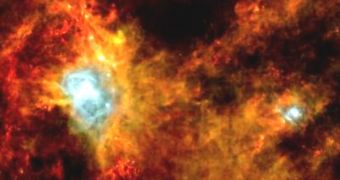The Herschel Space Observatory, the European Space Agency's new, advanced telescope, has recently started observing the Universe with unbelievable accuracy. As part of the first observations, it was pointed in the direction of the constellation Aquila, the Eagle. The structure is located some 1,000 light-years away, Deep within it, surrounded by massive clouds of cosmic gas and dust, lay a stellar nursery – a region of intense stellar formation. The advanced instruments aboard Herschel allowed it to make out about 700 new, forming stars in the structure, EurekAlert reports.
The new observations were only made possible by the superior sensitivity at the longest wavelengths of the infrared spectrum that Herschel had. The devices it uses were designed specifically for this type of missions, and are extremely apt at covering the full far-infrared and submillimeter wavebands. The most important instruments are the Photodetecting Array Camera and Spectrometer (PACS), the Spectral and Photometric Imaging Receiver (SPIRE), and the Heterodyne Instrument for the Far Infrared (HIFI). All the detectors are kept at temperatures below 2 degrees Kelvin (-271°Celsius).
For the first time ever, astronomers were able to peer deep inside the Eagle Nebula, using the PACS and SPIRE instruments on Herschel. They were able to determine that around 700 stars were being formed at the moment, or were in the earliest stages of their lives. The areas in the photo that appear most bright are also the regions where most of the new stars are concentrated. Their heat makes hydrogen gas glow bright in infrared wavelengths, astrophysicists report. The recent image was taken on October 24.
About 100 of the objects identified in the stellar nursery are protostars, which is to say they are on the final track towards becoming full-blown stars. It is widely believed in the scientific community that large clouds of hydrogen are usually the precursors of stars. They say that, when the clouds become too massive, they simply collapse onto themselves, under their own gravitational pull, and then ignite. If not all the cloud is consumed in the process, the remaining material creates a protoplanetary disk, which will eventually see the formation of planets, comets, asteroids, and everything in between.

 14 DAY TRIAL //
14 DAY TRIAL //